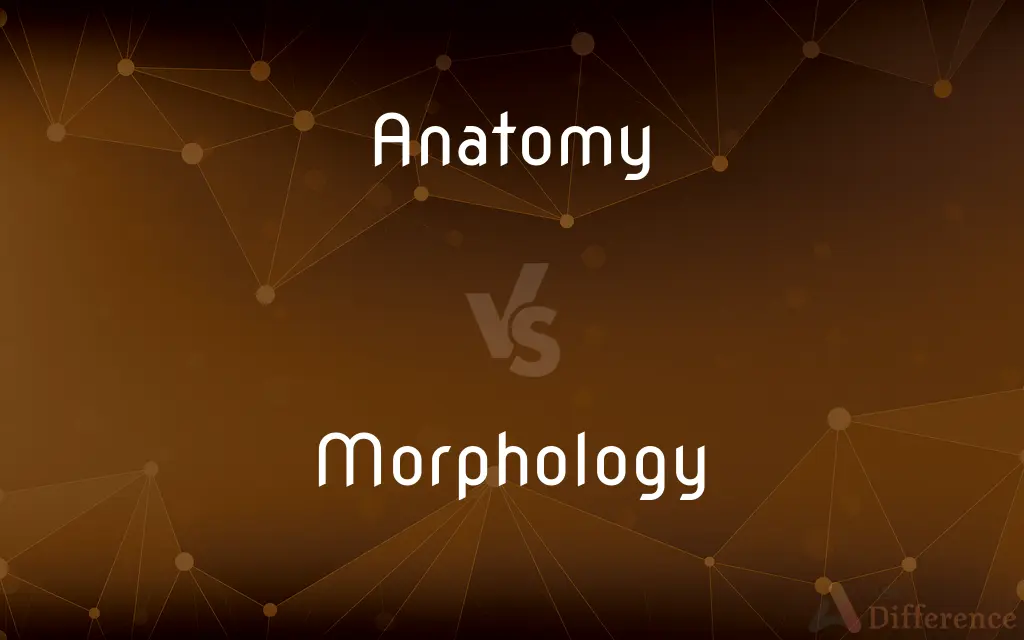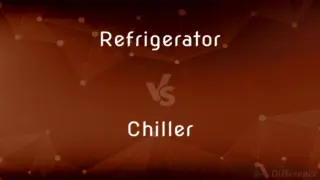Anatomy vs. Morphology — What's the Difference?
Edited by Tayyaba Rehman — By Fiza Rafique — Updated on September 21, 2023
Morphology studies the form and structure of organisms, encompassing both internal and external features. While anatomy is more specialized, morphology is broader.

Difference Between Anatomy and Morphology
Table of Contents
ADVERTISEMENT
Key Differences
Anatomy specifically concentrates on the structure of biological organisms. It delves deep into the internal aspects of organisms, such as bones, muscles, organs, and how they are interconnected. It provides an in-depth look at how biological systems are physically organized.
Morphology, by contrast, takes a broader approach. It studies the form and structure of things, often biological entities. This includes not just internal features like anatomy but also external ones like size, shape, and color. It might analyze the shape of leaves in a plant or the body structure of an animal.
While anatomy is often used in a medical context, for example, in human medicine or veterinary science, morphology finds broader application in biology, linguistics, and even in fields like geology and computer science. Anatomy is usually concerned with providing detailed information on individual parts and systems within the body.
Morphology can encompass anatomy as one of its subfields but goes beyond it. For instance, in linguistics, morphology will examine the structure of words. In biology, morphology would look at both the anatomical features of an organism and its external features like fur patterns or skin color. It serves as a more generalized field than anatomy.
Comparison Chart
Focus
Internal structures
Both internal and external structures
ADVERTISEMENT
Context
Mostly medical and biological
Broader, includes linguistics and geology
Scope
Specialized
Generalized
Applications
Medicine, veterinary science
Biology, linguistics, geology
Level of Detail
High, specialized
May vary, can be generalized
Compare with Definitions
Anatomy
The study of the internal structures of organisms.
She studied the anatomy of the human heart in medical school.
Morphology
Can be generalized or specialized.
Plant morphology can be as general as studying shapes or as specific as cellular structure.
Anatomy
Provides detailed insights into biological structure.
The anatomy of the eye is complex and intricate.
Morphology
The study of the forms of things.
Anatomy
Concerned with bodily systems and their interconnections.
Understanding the anatomy of the nervous system is crucial for neuroscientists.
Morphology
Broader in scope compared to anatomy.
Morphology includes anatomy but also studies external characteristics.
Anatomy
Focuses on components like organs, bones, and tissues.
The anatomy of a flower includes its reproductive organs.
Morphology
A particular form, shape, or structure.
Anatomy
Often used in medical contexts.
Anatomy classes are fundamental in a medical curriculum.
Morphology
The branch of biology that deals with the form and structure of organisms without consideration of function.
Anatomy
Anatomy (Greek anatomē, 'dissection') is the branch of biology concerned with the study of the structure of organisms and their parts. Anatomy is a branch of natural science which deals with the structural organization of living things.
Morphology
The form and structure of an organism or one of its parts
The morphology of a cell.
The morphology of vertebrates.
Anatomy
The bodily structure of a plant or an animal or of any of its parts.
Morphology
(Linguistics) The study of the structure and form of words in language or a language, including inflection, derivation, and the formation of compounds.
Anatomy
The science of the shape and structure of organisms and their parts.
Morphology
(uncountable) A scientific study of form and structure, usually without regard to function. Especially:
Anatomy
A treatise on anatomic science.
Morphology
(linguistics) The study of the internal structure of morphemes (words and their semantic building blocks).
Anatomy
Dissection of a plant or animal to study the structure, position, and interrelation of its various parts.
Morphology
(biology) The study of the form and structure of animals and plants.
Anatomy
A skeleton.
Morphology
(geology) The study of the structure of rocks and landforms.
Anatomy
The human body.
Morphology
(math) Mathematical morphology.
Anatomy
A detailed examination or analysis
The anatomy of a crime.
Morphology
(countable) The form and structure of something.
Anatomy
The art of studying the different parts of any organized body, to discover their situation, structure, and economy.
Morphology
(countable) A description of the form and structure of something.
Anatomy
The science that deals with the form and structure of organic bodies; anatomical structure or organization.
Animal anatomy is also called zootomy; vegetable anatomy, phytotomy; and human anatomy, anthropotomy.
Morphology
That branch of biology which deals with the structure of animals and plants, treating of the forms of organs and describing their varieties, homologies, and metamorphoses. See Tectology, and Promorphology.
Anatomy
(countable) A treatise or book on anatomy.
Morphology
The form and structure of an organism.
Anatomy
(by extension) The act of dividing anything, corporeal or intellectual, for the purpose of examining its parts.
The anatomy of a discourse
The anatomy of love
Burton's famous treatise, "The Anatomy of Melancholy"
Morphology
The branch of linguistics which studies the patterns by which words are formed from other words, including inflection, compounding, and derivation.
Anatomy
(colloquial) The form of an individual.
I went to the Venice beach body-building competition and noticed the competitor from Athens, and let me tell you, that's what I call classic Greek anatomy.
Morphology
The study of the patterns of inflection of words or word classes in any given language; the study of the patterns in which morphemes combine to form words, and the rules for combination; morphemics; as, the morphology of Spanish verbs; also, the inflection patterns themselves.
Anatomy
(euphemism) The human body, especially in reference to the private parts.
Morphology
The branch of biology that deals with the structure of animals and plants
Anatomy
(archaic) A skeleton, or dead body.
Morphology
Studies of the rules for forming admissible words
Anatomy
The physical or functional organization of an organism, or part of it.
Morphology
The admissible arrangement of sounds in words
Anatomy
The art of dissecting, or artificially separating the different parts of any organized body, to discover their situation, structure, and economy; dissection.
Morphology
The branch of geology that studies the characteristics and configuration and evolution of rocks and land forms
Anatomy
The science which treats of the structure of organic bodies; anatomical structure or organization.
Let the muscles be well inserted and bound together, according to the knowledge of them which is given us by anatomy.
Morphology
The study of the form and structure of organisms or things.
The morphology of this butterfly species is fascinating.
Anatomy
A treatise or book on anatomy.
Morphology
Includes both internal and external features.
Morphology covers everything from skeletal structure to skin patterns.
Anatomy
The act of dividing anything, corporeal or intellectual, for the purpose of examining its parts; analysis; as, the anatomy of a discourse.
Morphology
Found in various fields including biology and linguistics.
In linguistics, morphology studies the structure of words.
Anatomy
A skeleton; anything anatomized or dissected, or which has the appearance of being so.
The anatomy of a little child, representing all parts thereof, is accounted a greater rarity than the skeleton of a man in full stature.
They brought one Pinch, a hungry, lean-faced villain,A mere anatomy.
Anatomy
The branch of morphology that deals with the structure of animals
Anatomy
Alternative names for the body of a human being;
Leonardo studied the human body
He has a strong physique
The spirit is willing but the flesh is weak
Anatomy
A detailed analysis;
He studied the anatomy of crimes
Common Curiosities
Are anatomical studies more detailed?
Generally, anatomical studies are more specialized and offer greater detail on internal structures.
What is anatomy?
Anatomy is the study of the internal structure of organisms, including bones, muscles, and organs.
What is morphology?
Morphology is the study of the form and structure of organisms or things, both internal and external.
What subjects require knowledge of anatomy?
Subjects like medicine, biology, and veterinary science often require knowledge of anatomy.
Can morphology be studied in languages?
Yes, in linguistics, morphology studies the structure and formation of words.
What tools are used for studying anatomy?
Microscopes, MRIs, and dissections are common tools in anatomical studies.
Is anatomy a subset of morphology?
Yes, anatomy can be considered a specialized subset of morphology in a biological context.
Can morphology include non-biological things?
Yes, morphology is a broader term that can apply to fields like linguistics and geology.
Is anatomy limited to biology?
Mostly yes, anatomy is most commonly used in biological and medical contexts.
Is morphology used in medicine?
Less commonly than anatomy, but it can be used to describe shapes and structures in a medical context.
Can morphology be generalized?
Yes, morphology can be generalized or specialized depending on the field of study.
What subjects require knowledge of morphology?
Biology, linguistics, and even computer science and geology may require understanding of morphology.
What tools are used for studying morphology?
It varies by field but may include microscopes, language corpora, or geological samples.
Can anatomy be studied in plants?
Yes, plant anatomy studies the internal structure of plants.
Do anatomy and morphology overlap?
In biological contexts, anatomy is often considered a subset of morphology, so they do overlap to some extent.
Share Your Discovery

Previous Comparison
Licensed vs. Unlicensed
Next Comparison
Refrigerator vs. ChillerAuthor Spotlight
Written by
Fiza RafiqueFiza Rafique is a skilled content writer at AskDifference.com, where she meticulously refines and enhances written pieces. Drawing from her vast editorial expertise, Fiza ensures clarity, accuracy, and precision in every article. Passionate about language, she continually seeks to elevate the quality of content for readers worldwide.
Edited by
Tayyaba RehmanTayyaba Rehman is a distinguished writer, currently serving as a primary contributor to askdifference.com. As a researcher in semantics and etymology, Tayyaba's passion for the complexity of languages and their distinctions has found a perfect home on the platform. Tayyaba delves into the intricacies of language, distinguishing between commonly confused words and phrases, thereby providing clarity for readers worldwide.














































